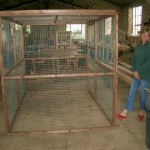Iguana Care Sheet
Article by Rob Stevenson
Iguanas are considered to be popular exotic pets these days and they tend to attract owners of all ages. However, due to the fact that most iguanas are designed to live in the tropical forests and deserts, it is difficult to properly take care of them while in captivity. There are so many important guidelines to follow when planning to keep an iguana. Luckily there is a wide range of information, discussions and photos on the internet that can teach you all that you need to know in order to take care of an iguana of your own.
Here are some of the basic iguana care sheet tips that should help you get started:
Habitat
Obviously you need to create a comfortable environment for you iguana and cages seem to be the most common enclosures that are used. The cage should be large enough to allow for comfortable roaming, climbing and relaxing. Even though you will probably purchase a baby iguana, you must be aware that it will grow to its full size of 6 feet in length. This means that either you can have a smaller cage at first and then change to a bigger one later on, or you could use a big one from the start. Also there must be adequate supplies of water, climbing materials and a hiding place. Generally you should use a cage that is double the size of your pet.
Food
Iguanas are herbivorous reptiles and therefore can only consume vegetable matter. It is recommended to feed your iguana green vegetables and fruit including broccoli, lettuce, blackberries, raspberries and oranges. You can also feed it tofu up to twice a week to change things up. It is essential that the food and water that you supply is fresh at all times. Otherwise the dirty water and spoiled food can lead to illnesses and health problems. Feeding your iguana first thing in the morning is advisable as it will enable plenty of time for proper digestion.
Temperature
Heating must be supplied in the cage either by a heat pad or light. Stay away from the use of hot rocks as these can burn and hurt your pet. The ideal heating temperature is 80 to 95 degrees Fahrenheit. Heating aids digestion and bodily functions and therefore you must ensure maximum and correct heating for your iguana.
Lighting
Iguanas require UV lighting to keep them in good shape. Lack of proper lighting will cause Metabolic Bone Disease or MBD, which can be dangerous. Fluorescent lights can be purchased from pet shops however the best lighting is supplied by the sun. So try and allow your iguana to laze around in direct sunlight during the day.
Sanitation
Your iguana and its habitat need to be very hygienic in order to ensure maximum health and safety. You should clean them on a regular basis to prevent illness. Iguanas also carry the bacteria known as Salmonella and so by cleaning your pet, you are preventing these dangerous micro organisms from flourishing on its body.
So, there you have it. Follow these simple care tips and you will have a healthy and happy iguana for years to come.
What to know more about iguanas? Click here!
About the Author
Rob Stevenson is an iguana enthusiast. If you want more information on how to raise iguanas or if you are looking for a more comprehensive Iguana Care Sheet feel free to visit .







